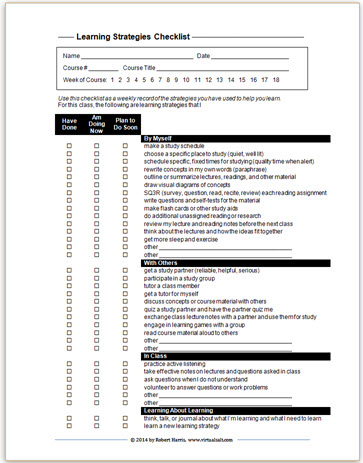Description
This strategy encourages you to try out various learning strategies and then check the boxes of the ones you have tried or are planning to try. The checklist
- gives you some ideas about what to try
- might suggest some things beyond the list itself
- encourages you to evaluate how well each strategy worked or didn’t work for you
Here is he checklist. You can get a pdf copy of the Learning Strategies Checklist to print out here. (Adobe Reader or other pdf file format reader is needed.)
Method
Use the checklist as follows.

Header area. The header area allows you to identify the course information as well as your own name. You can circle the number of the week in the course that the sheet represents. (Fill out a new sheet each week of the course, up to an 18-week semester.
Strategies area. Here you check the box when you have already used a specific learning strategy in the past. If you are still using it during this reporting week, then check the “Am Doing Now” box also. If you haven’t tried a strategy yet, or if you have in the past but aren’t doing it now, you might want to check the “Plan to Do Soon” box to get it on your agenda. The advantage of checking “Plan to Do Soon” is that it makes at least a mild commitment on your part to try out the strategy you have checked. You’re more likely to try to accomplish something you’ve declared in writing that you want to do than if you just keep it to yourself.
The ultimate goal is that, as the weeks of the term progress, (1) all the relevant boxes in “Plan to Do Soon” will be gradually checked and then later on unchecked as the checks move to “Am Doing Now”; and that by some point as early in the term as possible, every relevant box in the “Am Doing Now” column will be checked. (“Relevant” here means that a few items might not apply to the course, such as flashcards, getting a tutor for yourself, engaging in learning games, and so on. And the nature of the course might be all reading, so that active listening is not relevant. And if you are taking a course that does not have in-class meetings, such as a self-directed learning course, the “In Class” section won’t apply)
The checklist is useful not just for accountability or memory jogging, but it helps turn what otherwise would seem a daunting or impossible task into one that can be achieved by intentionally working at it.
Do take advantage of the “Other” lines in each section to explore creative ways to improve your learning. Discover some ways that are particularly effective for the course, subject, or your own style.
![]()
Choose two or three of the learning strategies and take them to the next level, as entries in the “Other” lines. Here are a few examples.
- From “draw visual diagrams of concepts” go to the next level by creating three-dimensional models. This works great for representing molecular structures, historical events (such as a Civil War battle), difficult to conceptualize things or places (such as ancient Israel’s portable tent-temple), etc.
- From “write questions and self tests for the material” go to the next level by writing an entire midterm or final examination.
- From “participate in a study group” go to the next level by making video where you explain (with relevant props and graphics) some item of content.